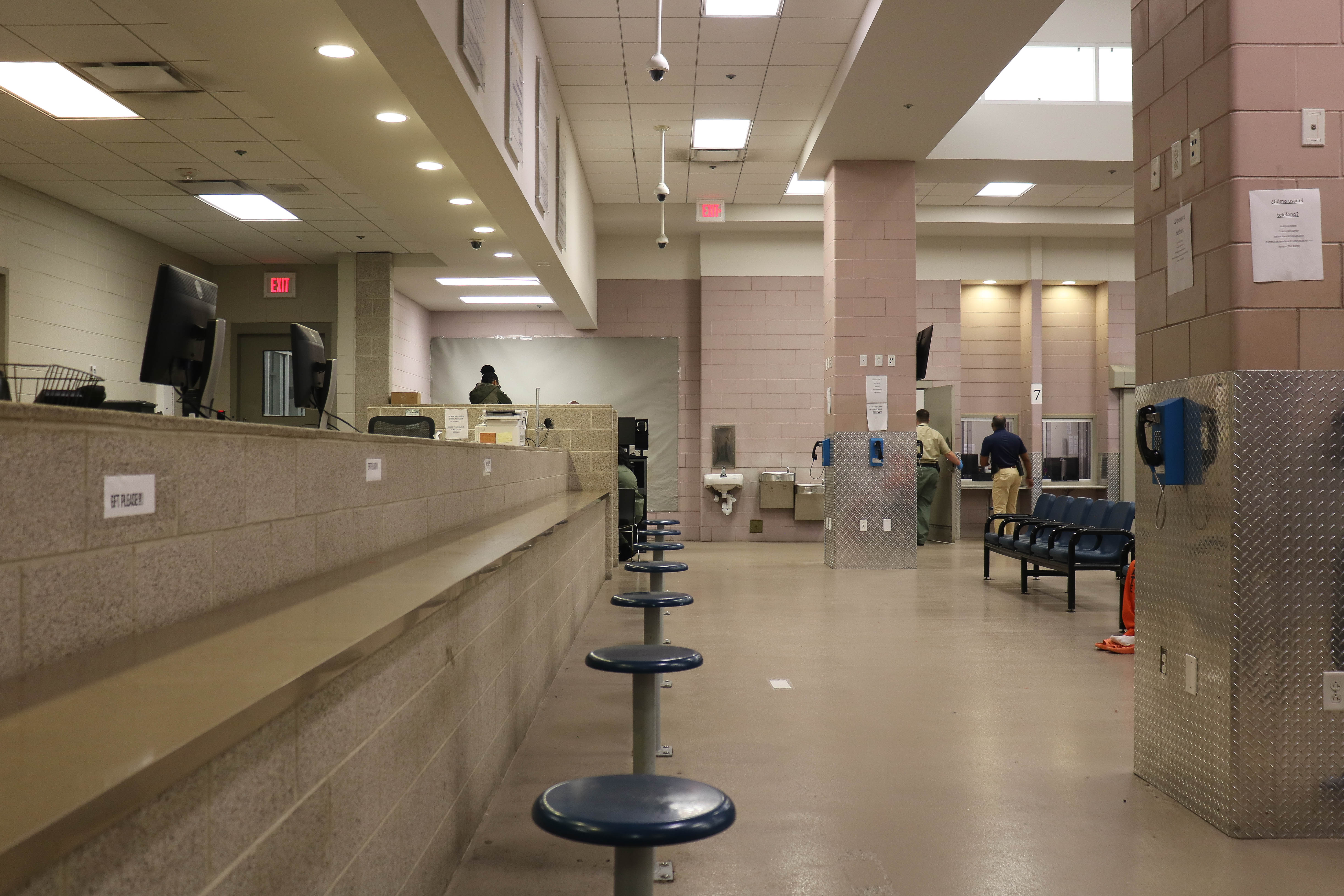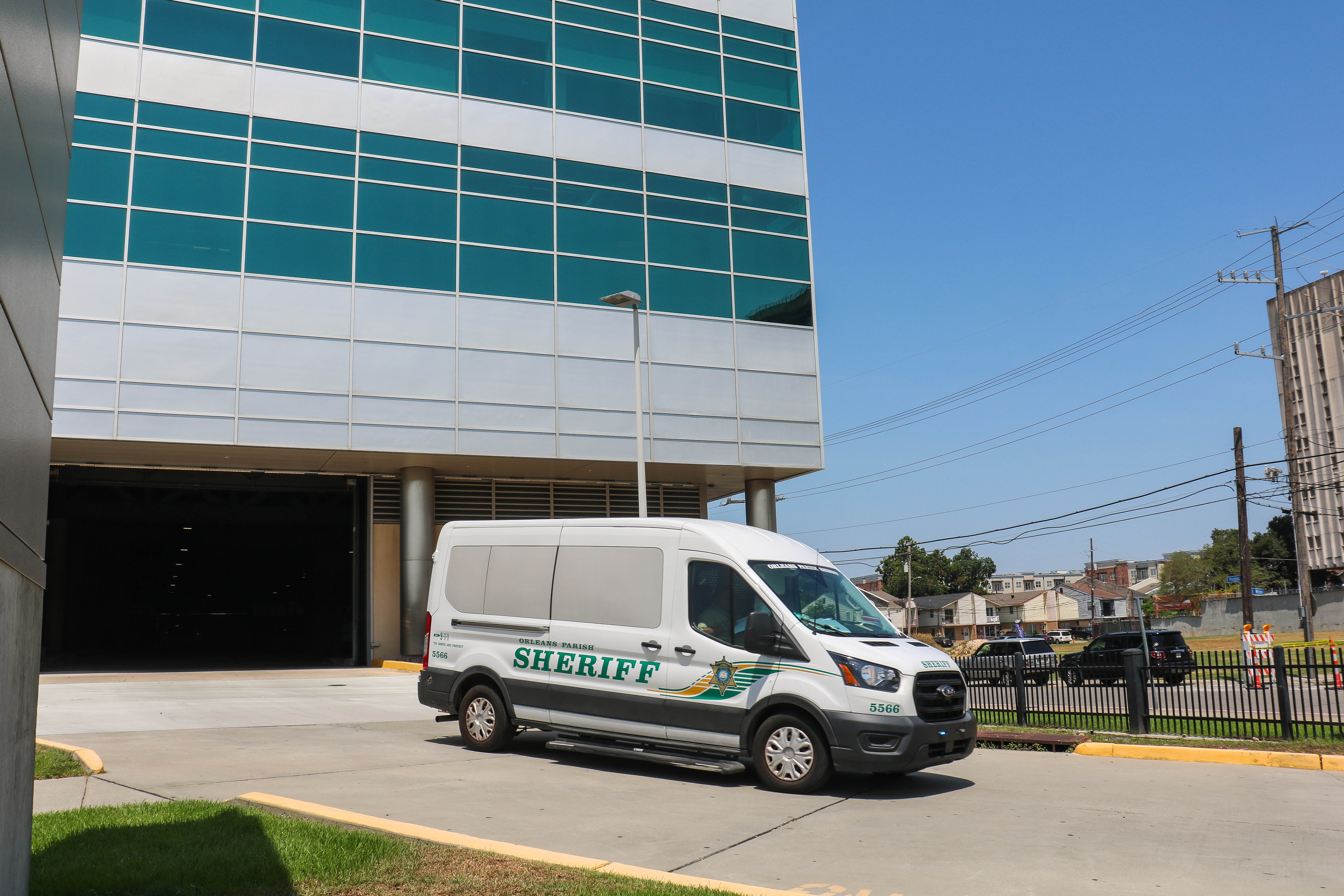The Orleans Justice Center, the city’s jail, has exceeded its city-mandated population cap of 1,250. As of Wednesday (June 19th), the City Council data dashboard showed that the Orleans Parish Sheriff’s Office had in its custody 1,322 individuals, 72 people beyond the cap set in 2019 by the council.
That’s nearly twice as high as the jail’s population of 734 in June 2021. Since that low, the city’s dashboard shows the population fluctuating up and down each day, but with an overall rise.
Since March 2024, as new legislation from the state’s special crime session took effect, the Orleans Parish Sheriff’s Office has seen a gradual but steady increase of 2%, said spokesperson Casey Ferrand McGee.
From March to June, the jail booked an average of 25 individuals a day on the weekends 35 individuals, higher than the average of those released, with April and May seeing the highest number of bookings versus releases this year. So far, as of June 13, the jail had booked 353 people – an average of 27 people per day – while only releasing 327 – an average of 25 per day.
“We have to release more people than we book to see any type of decline in the population,” Ferrand McGee said.
March was the only month this year that the jail released more people than it booked, she said. Then, finally in May, bookings dropped, she said. “Yet the jail population still went up, which is an indication that people are staying in custody longer, awaiting trial.”
What’s not quite clear is why bookings are increasing at a faster rate than releases. The jail’s longest-held person awaiting trial is approaching a decade in custody, more than nine years, Ferrand McGee said.
There’s no relief in sight. New legislation that ends parole and early release in Louisiana will take effect in August, filling up more beds at the state level, which will likely cause slowdowns in transfers of newly sentenced inmates from the jail. The recent deployment of the Louisiana State Police division Troop NOLA also is driving up arrest numbers. The Orleans Sheriff’s Department fears the jail population will further skyrocket.

Safety Concerns and Lack of Beds
Other fears lie within the walls of OJC. An inmate who asked to be referred to only as “Blakk” for this piece, believes that the population increases have led to an increase in fights and violence, because the intake tiers on the jail’s first floor are filling up quickly, so newly booked individuals must be moved from those tiers before they are acclimated to the jail’s culture. “If you got overflow in the intake, you start sending people upstairs before it’s time,” he said.
“There are a lot of people that have beef in the world,” he said. “Now you bring them straight to a tier where they are getting stabbed, and you try to figure out how that happened because you didn’t even give him a chance to stay in jail long enough to know where people are, where he can and can’t go.”
Though they have safeguards in place, asking people at booking about “known enemies” within the jail, the population rise is a threat to safety, acknowledged Ferrand McGee. That’s because of the city’s ongoing shortage of law enforcement staff, which doesn’t allow optimum ratios of deputies to inmates, she said, putting both at risk. As it becomes more difficult to maintain a safe environment, the jail will inevitably see more frequent altercations, infractions and use of force, she said.
The population cap is lower than the actual capacity of the OJC building, which has 1,376 beds. But currently, the capacity is 1,348, because 28 beds are not in use, because they need maintenance or on reserve within special units like suicide watch. That leaves almost no beds to spare in OJC.
As of June 13, the latest data available, there are 1,320 people housed within the OJC structure, 75 in a temporary overflow space, 18 in the jail’s temporary mental health unit, 22 at other facilities, two in the hospital and 15 juveniles.
The juveniles are all age 17 and their presence in the jail has contributed to the overall space crunch – and to prevailing concerns about safety. They were placed in the jail starting in mid-April after the state reversed its “Raise the Age” legislation, lowering the age of criminal jurisdiction from 18 to 17 in Louisiana.
Federal standards require that youth under 18 be kept separate from adult inmates. So the 15 teens in OJC take up an entire OJC 60-bed tier.

From the sprawling Orleans Parish Prison campus to OJC
The jail population reached its highest population of 7,542 in 2004, after then-sheriff Charles Foti started a jail empire, populated largely by prisoners, for which the state paid per diem fees to the Orleans Parish Sheriff’s Office. Given jail-size projections in the wake of Gov. Jeff Landry’s criminal-justice changes — which some experts say could nearly double the state’s prison population in a mere six years — it’s worth noting that the expansion of Orleans Parish Prison began after the state of Louisiana shut down admission to the notoriously brutal and overcrowded Louisiana Penitentiary at Angola. Without any prison slots for sentenced inmates, people were convicted and began to pile up at OPP and other local jails.
That’s when Foti began to create an entire jail campus between Interstate-10 and Tulane Avenue, using inmate labor to turn a motel, fire station, office building and school into jail buildings. The complex, with inmates in it, flooded heavily in the wake of the levee breaks after Hurricane Katrina. As the city struggled to rebuild, groups like the Orleans Parish Prison Reform Coalition successfully demanded that the city refuse to reinstate the sprawling jail, which at times was one of the nation’s largest jails, far disproportionate to the city’s population.
Mayor Mitch Landrieu appointed a Jail Population Management Subcommittee to determine the new jail’s size, which was originally set at 1,438 beds. OJC, which opened in late 2019, only holds people in custody until trial. Once sentenced, people are shipped out to a DOC facility.
After much debate, the City Council ultimately ruled to stop measuring jail size by beds; instead, the council in 2019 implemented a population cap of 1,250.
That’s now been surpassed.
Since last summer, it became clear that the jail’s population was slowly but steadily rising, the jail has convened Jail Population Management Unit that has been working within OPSO and other legal system entities to address the mounting problem – and to prioritize the processes related to jail admissions and releases from OPSO custody, Ferrand McGee said.
She said that the sheriff’s department is open to suggestions on its population-management work. “The jail population consists of people from the community and ultimately, requires all hands-on deck to ensure that people who should not be in custody are not and for those who are, that their needs are being met,” Ferrand McGee said.

Need for Data Transparency
But Ferrand McGee’s data is sometimes limited. At this point, she doesn’t always know the data and explanations behind inmates who are placed and kept there by the district attorney, judges, state probation and parole officers, New Orleans Police Department – and now, Troop NOLA.
Sarah Omojola, the director of the Vera Institute of Justice’s Louisiana office, said that her office is currently working on a memorandum of understanding agreement (MOU) with Orleans Parish Sheriff’s Office to help the sheriff create a campaign goal of data transparency.
“This would help New Orleanians know who is in the jail and why they are there,” Omojola said.
The sheriff does not determine who gets put in jail. But many other factors, Omojola said, determine who ends up in OJC.
Beyond the legal systems, it’s important to also scrutinize root causes of incarceration, such as poverty, lack of education and inadequate community resources, Omojola said.
“While we’re talking about how police are policing and how the district attorneys are deciding what to prosecute and how the judges are deciding how long of sentences to give people or how high a bail to charge people, we also need to talk about do we resource schools in low-income communities? How are we making sure that families have what they need? Are we making sure that kids have recreation all through the year, or that they have access to food and are not hungry all through the year,” Omojola said.
Yet currently, there is no big picture that puts together data from the courts, police, probation-parole and prosecutors. Once that happens, policymakers and advocates can better understand who is in the jail – and who may not need to be there.
This article has been updated to reflect that all juveniles held in the jail are 17 years old and that, unlike OPP, OJC is a pre-trial-only facility.


